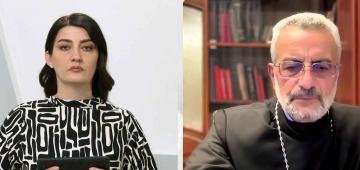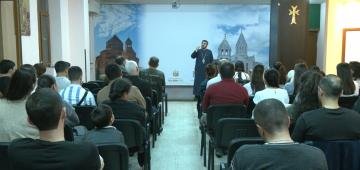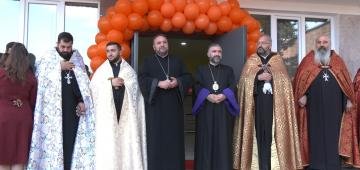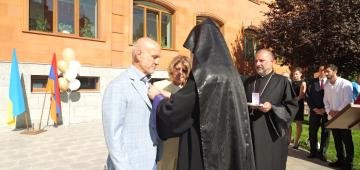 |
Rev. Fr. Yeghishe NazaryanWhat is the difference between morning and evening services?
|
 |
Rev. Fr. Mkrtich Yeranyan
What is the meaning of the dialogue between the deacon and the recipient during the distribution of blessed bread during the Liturgy?
Is there a Christian approach to hunger strikes?
Is it impermissible to greet clergy with a handshake?
Are the divine and human natures of Christ equally acceptable?
Can a meal with loved ones be called a “Love Meal”?
After giving life to Jairus’ daughter, why does Christ offer to give the girl bread, but not water?
Why is a crown placed on the heads of the newlyweds during a wedding?
Fr. Mkrtich Yeranyan answered the questions of viewers and users. Write your questions on the “Questions and Answers” Facebook page.
|
 |
Rev. Fr. Astvatsatur Sargsyan
Since when has giving a new name to a baptized person been practiced in our church?
Is it possible to participate in the rite of confession remotely, via the Internet?
What sources suggest that a clergyman cannot perform the rite for a suicide?
Why is the grave of women dug deeper than that of men?
Where are the stone tablets with the 10 commandments now located? T. Astvatsatur priest Sargsyan answered the questions of viewers and users. Write your questions on the “Questions and Answers” Facebook page.
|
 |
Father Vazgen Hovhannisyan
Where to start reading the Bible
What is Song of Songs about
Can illness have a spiritual basis
Why is there no mention of the story of Hayk and Bel in the Bible? Is it possible not to repent, but to approach communion
The questions of viewers and users were answered by Father Vazgen Hovhannisyan. Write your questions on the “Questions and Answers” Facebook page.
|
 |
Hovhannes Chilingiryan Library Opens at Gevorgyan Theological SeminaryThe Hovhannes Chilingiryan Library will operate in the Komitas Hall of the Gevorgyan Theological Seminary. The initiative was brought to life with the support of the daughters of the great Armenian, Shamir Avagyan Chilingiryan and Ani Srmakesh Chilingiryan. His Holiness awarded the spouses the highest order of honor of the Armenian Church, “Saint Gregory the Illuminator.” |
 |
Rev. Fr. Andreas Karapetyan
Is it possible to wear a headscarf outside the church?
Who is the people of the covenant?
Is it possible to baptize a newborn without waiting for it to turn 8 days old?
Can prayer be considered atonement for sins?
When did the tradition of seeing off the deceased from the church begin? How does something become sacred?
Fr. Andreas Karapetyan answered the questions of viewers and users. Write your questions on the “Questions and Answers” Facebook page.
|
 |
Ruben Sevak Museum presents Yervand Kochar's portrait of Saint Mesrop MashtotsThe exhibition of the decorative collection of Holy Etchmiadzin will be on display until November 1. After returning to Yerevan from Paris, Kochar painted a series of paintings dedicated to prominent Armenian figures, one of which is this painting. In 1962, he dedicated his work to Vazgen I, Catholicos of All Armenians, on the occasion of the 7th anniversary of his accession to the throne. |
 |
A church-owned Sunday school has opened near the Holy Mother of God Church in DashtavanThe clergy performed a Home-blessing ceremony, blessed the household goods, members, and benefactors. Sunday school groups will operate, youth union meetings will be held, as well as Bible study classes, and dinners will be organized after Sunday services. |
 |
Archimandrite Ruben Zargaryan delivered a speech for the people of ArtsakhThe Artsakh Diocese's "Entsa" Social-Spiritual and Psychological Center is organizing Bible study and interpretation courses for Artsakh youth. This time, the speaker for them was Archimandrite Ruben Zargaryan, a member of the Brotherhood of the Mother See. |
 |
Avetis Social-Cultural Center opened in Sevkar community of TavushA music school used to operate on the site of the Avetis Social and Educational Center. Over time, the building fell into disrepair and was in poor condition due to lack of renovation. In 2004, it was transferred to the Armenian Apostolic Church through the efforts of the late Archbishop Sepuh Chuljyan. Since May 2025, the Vicar of the Tavush Diocese, Archbishop Samvel Mkhitaryan, has been seeking the help of benefactors to thoroughly renovate the center. |
 |
Rev. Fr. Shmavon GhevondyanWhy are there five tabernacle feasts?
|
 |
The opening ceremony of the Armenian-Ukrainian International School took place in OdessaThe official opening ceremony of the Armenian-Ukrainian International School was held under the chairmanship of Bishop Markos Hovhannisyan, Primate of the Armenian Diocese of Ukraine. The construction of the church-owned school began in 2021 and was built with the funds of the Grigor Lusavorich Charitable Foundation. Education is bilingual, with the main subjects being Ukrainian. The school is designed for 100 students. |
